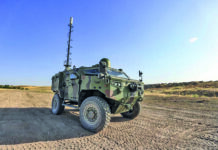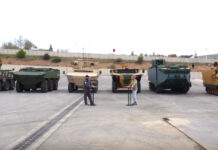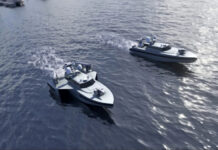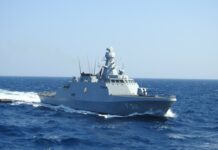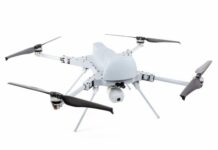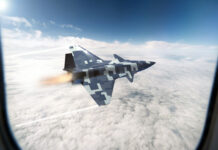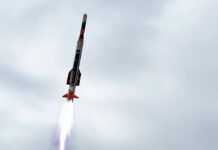The Turkish Armed Forces are in for a “Digital Transformation” and have adapted to the concepts of Artificial Intelligence (AI), Unmanned Technologies and C5I. The ‘soldier-machine interaction’ interface will serve as the basis for advancing the “Digital Troops” concept.
The latest areas of interaction within the Turkish Armed Forces are between the Air Force and the Army, the Army and the Navy, the Navy and the Air Force, thereby forming a kind of strategic triad. The “Digital Troops” concept should encompass three important characteristics: the speed of the units; the effectiveness of the attacks; and the breadth of the intervention, especially supported by the use of AI and cognitive machines. The first steps in the direction of the “transformation process into digitalisation” began 20 years ago with the project “Air Force Command Information Management System – AFCIMS” which was not common in NATO at that time. From that time onwards, the Turkish General Staff understood how to introduce digitalisation on a step-by-step basis and to adopt a new military doctrine. Today’s successes of Turkish UAVs in different trouble spots are due to the AFCIMS project. In this regard, the Turkish Army Fund is the catalyst for progress in this domain.
Command Control and Battle Management
According to Havelsan, the Battle Management Effectiveness & Decision Support System is currently defined by seven parameters within the area of “Operational Components”, these are C2:
- Intelligence
- Fire Support
- Survival
- Air Defence
- Manoeuvering
- Combat Service Support (Combat Logistics)
The generated data space is transferred to the area of situational awareness, where the Cynefin Decision-Making Framework plays an important role in shaping the Combat Skills and Mission Requirements, which is an important contribution to building Adaptive and Cognitive Systems (A&CS). “Digital Troop Technologies” are basically A&CS and currently consist of:
- Advanced Training and Combat Readiness Systems
- Mobile Agile and Network-Enabled Command Control
- Conventional Combat Elements
- Smart Information Systems
- Integrated Autonomous
- Robotic Systems
- Digital Soldier (CENKER)
The main goal is the absolute functionality of the system-of-systems and thus the optimal use of the sensor-to-shooter system. This means that the task-oriented or dedicated systems are collected here, which combine their resources and capabilities into a new, more complex system, thereby creating more functionality and performance in total than with individual combat systems. The challenge in Future Warfare Environment in all domains (Air/Land/Sea) is the balanced and effective use of C2 systems; here both companies – Aselsan and Havelsan – have developed C2s for the Turkish Armed Forces, mentioning Agile Command & Control Systems, Network-Centric Command & Control Systems, Mobile Command & Control Systems, Genesis ADVENT (Navy) and HAKIM (Air Force) where AI is applied.
To bring the effectiveness of the C2 systems to the highest level, extremely complex communication systems must be equipped, and in this regard Aselsan has developed new radio and satellite communication systems that reach from headquarter(s) to the front. Of course, C2 systems are constantly evolving and have begun to take over some of the human decision-making, but it remains to be seen whether the incoming data from battlefield information systems will finally be taken over by virtual AI. MilSOFT has developed a combination of sophisticated system platforms for UAVs and drones, which, in combination with the different domains, generate a special role for frequency management and data management in the operational area or for the battlefield. This is basically a data fusion platform where data from different sources is collected by special intelligence solutions and bundled, analysed and processed by innovative algorithms to create a dynamic situation picture.
Functionality, starting from Link-M(ilitary) is a Tactical Data Link System that enables tactical data exchange between land, sea and air platforms using existing or new HF and V/UHF radios. This is supported by the Multi Data Link Processor, with this meeting the main requirements for network-centric capability to NATO standards. However, at the heart of this is the MilSOFT Intelligence System (Mil-INTEL), which is designed for efficient and effective analysis of various types of intelligence data, allowing intelligence officers to search through all data at high speed and extract meaningful information from it, thereby performing multi-dimensional analysis using different views and sharing analysis with other officers as needed. These platforms can show an overall picture of the area of operation with different map views (2D/3D), provide video/sensor data in real time and enrich it with additional analysis tools. We are talking about a sensor-to-shooter that creates the tactical picture and provides the operator with support functions to enable effective decision-making.
Future Soldier Systems
Regarding the archives of the SSB, formerly SSM, the first official event regarding the future Turkish soldier system started at the SSM (Ministry of Defence) and Training and Doctrine Command under the name “1st Single Private Modernisation Of the Future” on 23 December 2008. The current version of CENKER consists of two main system landscapes: “Situational Awareness Based on Wearable Sensors” and “Augmented Reality in Operational Environment”.
In Situational Awareness Based on Wearable Sensors, the future infantry troops are enabled to permanently connect to “Operation Centre” and “Tactical Command & Control” via the various communication channels in the digital environment, thus supporting their situational awareness in real time. While at the same time, the “Wearable Sensors” collect information about the soldier’s physical condition based on “Body Motion Analysis”, which is transmitted to the centre. The infantryman interfaces with drones and Unmanned Ground Vehicles (UGV) via the EO/Thermal Camera and protected gateway to carry out the mission, and of course, the weapon is interactively connected to the corresponding network. In Augmented Reality in Operational Environment, the infantryman has a connection to the “Combat Cloud” through various interfaces and “Edge Unit”. Through the “Deep Neural Networks” and the “Data Processing” with the support of the 3D Visualisation Engine, a digital twin of the battlefield will be generated. Of course, CENKER will maintain its proximity to the allied standards “Soldier System Engineering Architecture (USA)”, “Generic Soldier Architecture (NATO)” and “Generic Open Soldier Systems Reference Architecture (EU)”. If required, CENKER can be equipped with an exoskeleton, whereby the weight can be reduced to 1/8 of the total weight.
Additionally, BITES, a software company that Aselsan is involved with, has developed with another 12 companies the ATOK, which stands for Military Tactical Operations Kit. This kit consists of portable integrated technologies designed to maximise the security of troops. An armoured mobile platform 4×4 equipped with 5G mobile network from the company ULAK and portable technologies such as a geo-information system and VR glasses will support military sub-units up to 15 soldiers. In addition, a specially developed messaging software enables the sharing of all kinds of information. The system is currently designed for close quarter combat and attempts are being made to harmonise the interface between soldiers and mobile platforms in cellular networks. The second phase of the project, specifically the off-road capability, started in October this year.
Swarming Technologies
Havelsan is developing swarm technologies for the next generation of unmanned vehicles including swarm algorithms that allow one unmanned vehicle to know the location, mission and distance of another unmanned vehicle. In this way, unmanned vehicles are not only coordinated with each other, but are able to perform different tasks together. Therefore, the interaction of the swarm’s capabilities on all platforms – air, land, underwater and surface – is known as ‘herd intelligence’. MilSOFT’s swarm system, which was presented in November 2020, consisted of five drones and this also worked in the simulation environment with 25 drones. MilSOFT should be able to carry out reconnaissance, detection and surveillance of areas and objects so that the engagement of targets becomes feasible. Here, an communication system within the swarm has been developed. The drones can communicate up to 500 metres apart, but there is also another solution that allows them to communicate at a distance of 10 km.
The information obtained in the swarm will be able to be transferred between units with a relay function, and the type of armament of the unmanned vehicles will allow attack options to be enabled. Tests are being conducted on how to transmit commands from helicopters to the swarms, including manned-unmanned teaming. In the future, the swarm system will be able to carry out sub-tasks completely on its own – though a complete autonomy of the systems is not planned. Furthermore, the company STM is developing a swarm technology framework for rotorcraft (multi-rotor) and fixed-wing drones in non-GPS environments.
Domain Air
In the Turkish small-rotor drone development environment, many companies have been established and all of them have set up R&D departments, thanks to state subsidies. In contrast to the UAV industry, the industrial landscape here is diverse. Especially in the conflicts in Nagorno-Karabakh between Armenia and Azerbaijan, in Libya and in Syria, Turkish drone swarms have attacked enemy tanks, missile systems, radars and command centres to affect the course of the war which has attracted public attention.
In the beginning, battles are undoubtedly controlled by soldiers, but as the combat process becomes more intense, the drones will take action without human intervention. All these systems will go through the OODA (Observe, Orient, Decide, Act) military command and control process and may make decisions in a few seconds; the motto being, whoever is faster than their enemy will dominate the battle and win the war. A recent UN report claims that the Turkish drone KARGU-2 eliminated its target in Libya without a “man in the loop”; in a fully autonomous procedure as a killer robot. This was denied by the Turkish SSB President Ismail Demir, who said that in this case a soldier was at the end of the decision-making process and stopped the attacker shortly before the act.
Several dozen companies operate in the Turkish industrial landscape and STM is the only example selected here. STM has developed disposable drones or ‘kamikaze drones’ called ALPAGU, which are armed with explosives and weigh about 4 kg. They are programmed to pursue their target in solo or in formations and engage targets such as a concentration of enemy fighters or armoured vehicles. These disposable drones are released from launchers and can fly for about 20 minutes in the air with an effective range of up to 5 km and an altitude of 100 m. The speed of these drones is said to be about 120 km/h. From the same company, KARGU, is an ISR drone equipped with thermal sensors and technically advanced reconnaissance and combat optics and has man-in-the-loop capability. It has a range of about 5 km with a mission duration of 15 minutes and 72 km/h speed, a maximum mission altitude of 2,500 m and a combat weight of about 6.3 kg.
A final example is TOGAN, a reconnaissance drone with almost the same dimensions as the KARGU, but which can remain in action for 50 minutes at an altitude of 3,300 m. The Turkish small drones have the capability to operate in swarms but in the near future, huge swarms of AI-controlled processors will complete missions that will far exceed the capability of human commanders. A special role in the drone market will be played by DASAL, a Joint Venture between Aselsan and Altinay, which offers multi-rotor drones in four sizes: mini, small, medium and large, with a wide range of variants. A hand-sized mini drone weighing a few hundred grammes and the large ALBATROS drone weighing about 700 kg, offering a payload of up to 150 kg, will not only play an important role at the operational level for troops, but also generate new markets.
Domain Land
In the last decade, the development of UGVs has really benefited from new technologies, although they currently operate as remote-controlled robots, but will soon be involved in missions independently. The SSB developed a plan for UGVs a few years ago and they are supposed to have the following capabilities:
- maintenance
- autonomy
- mobility
- combat capability
These UGVs are divided into three categories, light, medium and heavy. The light category includes three types of tactical robots weighing between 1 – 6 kg. They are equipped with drop-cams (360 real-time recording), loudspeakers and are used in urban environments for tasks ranging from reconnaissance, surveillance and observation to bomb disposal. Many Special Forces units have been equipped with them. In the case of medium-heavy UGVs, SSB tendered two sizes, one at 500 kg and the other at 2.5 tonnes. In the former category, four UGVs have recently made it to the final selection for the Turkish Land Forces – Aselsan, with its ASLAN UGV, while Havelsan’s BARKAN, Best Group’s FEDAI and Elektroland Defence’s HANCER, are competing against each other. All four UGVs are equipped with Aselsan’s SARP remotely operated weapon system, plus electro-optical sensors, data link systems. The finalists conducted firing tests with their 7.62 mm guns, and the competition will be completed later this year and this is expected to go into series production. All vehicles meet the requirement of digitisation interface for the Turkish Future Soldier System. In the category of 2.5 tonne UGVs, the tender will be announced by SSB this year, and some companies have also submitted bids. Here, the company Katmerciler will stand out. In this class, the UGVs should have the following characteristics: reconnaissance, surveillance and target marking. With their dimensions, they are able to carry heavy weapon systems such as anti-tank missiles, especially as load carriers and, if necessary, the ability to transport injured persons out of difficult terrain. The heavy UGVs are 14 to 25 tonne 4×4 vehicles, namely EJDER YALÇIN from Nurol Makina, KIRPI II and AMAZON from BMC. These platforms will primarily be used for logistical tasks and reconnaissance in risky terrain. They will be especially equipped with high firepower and integrated with powerful machines for mobility. The UGVs will interface with the land vehicles of the Turkish Army and will have intensive manned-unmanned teaming with the latest generation 6×6 and 8×8 armoured vehicles. At the IDEF’21, FNSS presented the SHADOW WARRIOR, a tracked tank that can move autonomously on the terrain and perform autonomous missions in the compound. The company BMC has introduced the AMAZON model, a 4×4 armoured vehicle equipped with a drone that also operates autonomously. Both vehicles have multiple sensors and a LIDAR (light imaging, detection and ranging) system, a technology that scans the environment in three dimensions using laser technology.
Domain Sea
The Turkish Navy has received a ULAQ Unmanned Surface Vehicle (USV), a cooperative project between Ares Shipyard and Meteksan. This USV is capable of operating alone, as well as in conjunction with innovative communication systems. Primarily, it is used to maintain coastal security, carry out coastal landings and port controls, but by attaching sensors and existing missile armaments, it increases situational awareness in real time.
The USVs are linked to GENESIS ADVENT (Network Supported Data Integrated Combat Management System), a Next Generation Command Control System developed specifically for the Turkish Navy. Recently, Aselsan and Sefine Shipyard launched a project that will enable Unmanned Naval Vehicles to hunt submarines through its modular design and trimaran concept with the ability to pick up torpedoes and missiles, and even sonobuoys. The defence industry is in the process of manufacturing Unmanned Underwater Vehicles (UUVs). Armelsan has developed remotely operated underwater vehicles; it is also certain to develop UUVs to track enemy submarines and divers if needed. From defence circles, it has been heard that the Navy is in the process of developing a wireless underwater communication network. Because of the difficult underwater environment due to numerous reflections, sonar signals and noise, the challenges for underwater operations are very high, but in the future, UUVs will become an important component for manned submarines. Moreover, the LPD ANADOLU will be converted into an aircraft carrier of unmanned systems, including different drones and combat drones for water, air and land. A second carrier called LPD TRAKYA is in the waiting.
The “New Security Doctrine in 2023”
On Turkish Armed Forces Day, the groundbreaking ceremony for the new Turkish Pentagon, a crescent with a star based on the Turkish flag, was held by Turkish President Recep Tayyip Erdoğan on 30 August 2021. The first phase of the Turkish Pentagon, which consists of several building complexes, will be opened on 19 May 2023 (the Commemoration of Atatürk, Youth and Sports Day). After completion, the National Defence Ministry, the General Staff, and the headquarters of the Air Force, Navy and Army will be located there. More than 15,000 people will work in an area of 890,000 m2; only the reception complex with a size of 4,625 m2. The new headquarters of the Turkish Armed Forces and Ministry of Defence will include one of the largest military operations centres in the world and will also include several bunker complexes. At the beginning of last year, 6 January 2020, the new headquarters of the Turkish intelligence service, Milli İstihbarat Teşkilatı (MIT) was ceremonially opened, which is located exactly in the neighbourhood of this Turkish Pentagon.
Conclusion
The focus of the concept, future “Digital Troop” will be that they will have one or more command and control centres that will enable coordinated action in real time between unmanned systems and manned units, so that, among other things, decisions can be made as to which countermeasures can be deployed when and where. It is obvious that human decision-making in the battle process will steadily decrease and be automated by machines, because in “Digital Battlefield” time, direction and resources will have absolute priority. The Turkish General Staff, as well as the defence industry, are fully aware that the Networked Unmanned Technologies will determine the fate of wars in the near future. But the unmanned systems also have an Achilles heel, because the range and the deployment time is currently a major limitation for these modern warfare assets. In this regard, Aspilsan, a company of the Turkish Army Fund with several technology companies, is working on innovative energy storage technologies. Succinctly, the Turkish Armed Forces’ digitalisation strategy is based on three main pillars, “Transformation”, “Holistic” and “Intelligence”.




